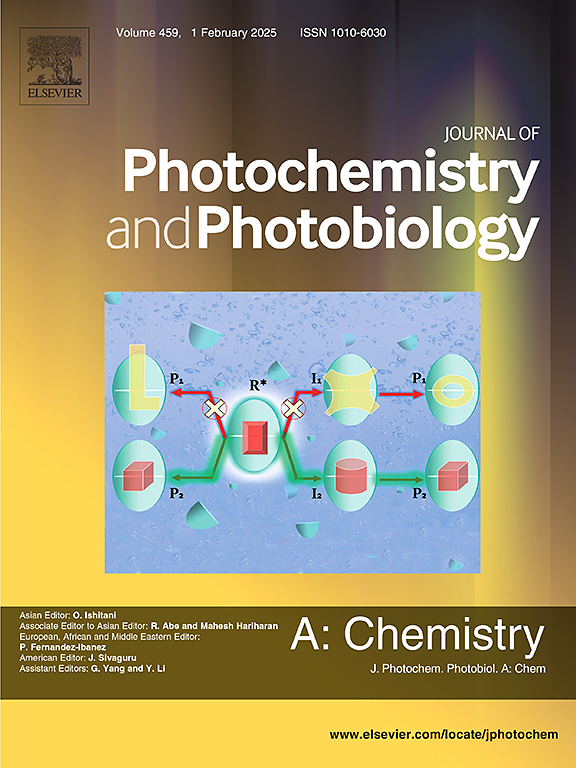Enhanced photoluminescence properties of Eu3+/Li+ co-doped ZrO2: A focus on red and far-red emissions
IF 4.1
3区 化学
Q2 CHEMISTRY, PHYSICAL
Journal of Photochemistry and Photobiology A-chemistry
Pub Date : 2025-03-24
DOI:10.1016/j.jphotochem.2025.116408
引用次数: 0
Abstract
In this study, Eu3+ and Li+ co-doped ZrO2 nanophosphors were synthesized using a microwave-assisted gel combustion method. While the synthesis method ensures phase stabilization, it does not directly enhance photoluminescence (PL) intensity. Instead, the observed PL enhancement originates from Li+ co-doping, which improves charge compensation and modifies local symmetry. Structural analysis confirmed the stabilization of the tetragonal phase due to Li+ co-doping, which introduced controlled oxygen vacancies. These structural changes led to a 4.67-fold intensity enhancement in red emission at 611 nm (5D0 → 7F2 transition), and a 4.26-fold increase in far-red emission at 711 nm (5D0 → 7F4 transition). Optimal doping concentrations of Eu3+ (0.02) and Li+ (0.03) achieved the highest luminescence intensity while maintaining color purity values up to 88.71 %. High-temperature PL measurements revealed stable emission peaks up to 550 K, demonstrating the material’s thermal stability despite intensity reductions due to thermal quenching. These findings establish Eu3+/Li+ co-doped ZrO2 nanophosphors as promising candidates for solid-state lighting, plant growth lighting, and optoelectronic applications requiring enhanced red and far-red emissions.

Eu3+/Li+共掺杂ZrO2的增强光致发光特性:聚焦于红光和远红光发射
本研究采用微波辅助凝胶燃烧法合成了Eu3+和Li+共掺杂的ZrO2纳米荧光粉。虽然合成方法保证了相稳定,但并不直接提高光致发光(PL)强度。相反,观察到的PL增强来自于Li+共掺杂,它改善了电荷补偿并改变了局部对称性。结构分析证实了由于Li+共掺杂导致的四方相稳定,引入了可控的氧空位。这些结构变化导致611 nm处(5D0→7F2跃迁)红光发射强度增强4.67倍,711 nm处(5D0→7F4跃迁)远红光发射强度增加4.26倍。Eu3+(0.02)和Li+(0.03)的最佳掺杂浓度可获得最高的发光强度,同时色纯度可达88.71%。高温PL测量显示稳定的发射峰高达550 K,证明了材料的热稳定性,尽管强度降低由于热淬火。这些发现确立了Eu3+/Li+共掺杂ZrO2纳米荧光粉作为固态照明、植物生长照明以及需要增强红光和远红光发射的光电应用的有希望的候选者。
本文章由计算机程序翻译,如有差异,请以英文原文为准。
求助全文
约1分钟内获得全文
求助全文
来源期刊
CiteScore
7.90
自引率
7.00%
发文量
580
审稿时长
48 days
期刊介绍:
JPPA publishes the results of fundamental studies on all aspects of chemical phenomena induced by interactions between light and molecules/matter of all kinds.
All systems capable of being described at the molecular or integrated multimolecular level are appropriate for the journal. This includes all molecular chemical species as well as biomolecular, supramolecular, polymer and other macromolecular systems, as well as solid state photochemistry. In addition, the journal publishes studies of semiconductor and other photoactive organic and inorganic materials, photocatalysis (organic, inorganic, supramolecular and superconductor).
The scope includes condensed and gas phase photochemistry, as well as synchrotron radiation chemistry. A broad range of processes and techniques in photochemistry are covered such as light induced energy, electron and proton transfer; nonlinear photochemical behavior; mechanistic investigation of photochemical reactions and identification of the products of photochemical reactions; quantum yield determinations and measurements of rate constants for primary and secondary photochemical processes; steady-state and time-resolved emission, ultrafast spectroscopic methods, single molecule spectroscopy, time resolved X-ray diffraction, luminescence microscopy, and scattering spectroscopy applied to photochemistry. Papers in emerging and applied areas such as luminescent sensors, electroluminescence, solar energy conversion, atmospheric photochemistry, environmental remediation, and related photocatalytic chemistry are also welcome.

 求助内容:
求助内容: 应助结果提醒方式:
应助结果提醒方式:


